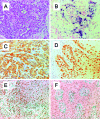Relationship among human papillomavirus infection, p16(INK4a), p53 and NF-κB activation in penile cancer from northern Thailand
- PMID: 22966350
- PMCID: PMC3436469
- DOI: 10.3892/ol_00000106
Relationship among human papillomavirus infection, p16(INK4a), p53 and NF-κB activation in penile cancer from northern Thailand
Abstract
Human papillomavirus (HPV) E6 and E7 oncoproteins are essential factors for HPV oncogenesis. These E6 and E7 gene products play a central role in the induction of malignant transformation by interacting with several cellular regulatory proteins such as p16(INK4a), p53 and nuclear factor κB (NF-κB). In the present study, conducted in northern Thailand, HPV-DNA was detected in penile cancer cases using an in situ hybridization procedure and p16(INK4a), p53 and NF-κB were detected by immunohistochemistry. Using the cell cycle regulatory proteins p16(INK4a) (61.5%) and p53 (71.8%), it was found that of the 51 cases, 39 (76.5%) were HPV-DNA-positive in penile cancer. On the other hand, 25% p16(INK4a) and 75% p53, respectively, were found in HPV-negative cases. Prevalence of HPV infection (76.5%) was shown in penile cancer cases in northern Thailand. No difference was found between HPV-positive and HPV-negative cases with respect to the presence of the cell cycle regulatory protein p53. On the other hand, p16(INK4a) was found to be different between HPV-positive and HPV-negative cases. Inactivation of tumor suppressor genes, such as p16(INK4a) and p53, to genetic instability, cell immortalization, accumulation of mutations and cancer formation, with or without HPV and irrespective of HPV infection, is therefore suggested. Of the 39 HPV-positive cases, 35 (89.7%) were NF-κB-positive in the nucleus, 29 (74.4%) in the cytoplasm and 37 (94.9%) in the nucleus and/or cytoplasm. NF-κB was detected in 4 (33.3%) of the 12 HPV-negative cases. Therefore, we propose that penile cancer cases with HPV infection are more likely to activate NF-κB than those without HPV infection.
Figures
Similar articles
-
Detection of Human papillomavirus and cellular regulators p16INK4a, p53, and NF-kappaB in penile cancer cases in Kenya.Acta Virol. 2009;53(1):43-8. doi: 10.4149/av_2009_01_43. Acta Virol. 2009. PMID: 19301950
-
p16(INK4a) overexpression predicts translational active human papillomavirus infection in tonsillar cancer.Int J Cancer. 2010 Oct 1;127(7):1595-602. doi: 10.1002/ijc.25174. Int J Cancer. 2010. PMID: 20091864
-
Human papillomavirus infection in Bowen disease: negative p53 expression, not p16(INK4a) overexpression, is correlated with human papillomavirus-associated Bowen disease.J Dermatol. 2014 Oct;41(10):878-84. doi: 10.1111/1346-8138.12613. Epub 2014 Sep 9. J Dermatol. 2014. PMID: 25201325
-
Prevalence of human papillomavirus DNA and p16INK4a in penile cancer and penile intraepithelial neoplasia: a systematic review and meta-analysis.Lancet Oncol. 2019 Jan;20(1):145-158. doi: 10.1016/S1470-2045(18)30682-X. Epub 2018 Dec 17. Lancet Oncol. 2019. PMID: 30573285
-
[Targeting p16(INK4a) by therapeutic vaccination : Concept and status of clinical investigations in HPV-associated head and neck cancers].HNO. 2015 Feb;63(2):104-10. doi: 10.1007/s00106-014-2944-z. HNO. 2015. PMID: 25515124 Review. German.
Cited by
-
The frequency of high-risk human papillomavirus types, HPV16 lineages, and their relationship with p16INK4a and NF-κB expression in head and neck squamous cell carcinomas in Southwestern Iran.Braz J Microbiol. 2021 Mar;52(1):195-206. doi: 10.1007/s42770-020-00391-1. Epub 2020 Nov 9. Braz J Microbiol. 2021. PMID: 33169334 Free PMC article.
-
Geographical risk pattern and temporal trends in incidence of HPV-related cancers in northern Thailand: A population-based study.PLoS One. 2022 Jun 28;17(6):e0270670. doi: 10.1371/journal.pone.0270670. eCollection 2022. PLoS One. 2022. PMID: 35763509 Free PMC article.
-
DNA Copy Number Aberrations, and Human Papillomavirus Status in Penile Carcinoma. Clinico-Pathological Correlations and Potential Driver Genes.PLoS One. 2016 Feb 22;11(2):e0146740. doi: 10.1371/journal.pone.0146740. eCollection 2016. PLoS One. 2016. PMID: 26901676 Free PMC article.
-
Inflammation in Penile Squamous Cell Carcinoma: A Comprehensive Review.Int J Mol Sci. 2025 Mar 19;26(6):2785. doi: 10.3390/ijms26062785. Int J Mol Sci. 2025. PMID: 40141426 Free PMC article. Review.
-
Mechanisms of virus immune evasion lead to development from chronic inflammation to cancer formation associated with human papillomavirus infection.Oncol Rev. 2012 Oct 5;6(2):e17. doi: 10.4081/oncol.2012.e17. eCollection 2012 Oct 2. Oncol Rev. 2012. PMID: 25992215 Free PMC article. Review.
References
-
- Tornesello ML, Duraturo ML, Losito S, et al. Human papillomavirus genotypes and HPV 16 variants in penile carcinoma. Int J Cancer. 2008;122:132–137. - PubMed
-
- Gross G, Pfister H. Role of human papillomavirus in penile cancer, penile intraepithelial squamous cell neoplasias and in genital warts. Med Microbiol Immunol. 2004;193:35–44. - PubMed
-
- Senba M, Mori N, Wada A. Oncogenesis and the link between inflammation and cancer due to human papillomavirus (HPV) infection, and the development of vaccine control strategies. Cancer Res J. 2009;2:307–338.
-
- Zhang HS, Postigo AA, Dean DC. Active transcriptional repression by the Rb-E2F complex mediates G1 arrest triggered by p16INK4a, TGFb, and contact inhibition. Cell. 1999;97:53–61. - PubMed
LinkOut - more resources
Full Text Sources
Research Materials
Miscellaneous

